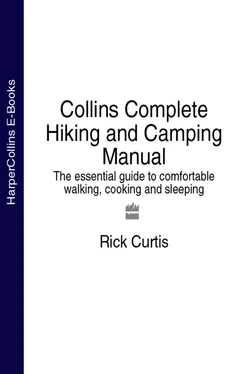ESTIMATING TRAVEL TIMES
As part of planning your route you want to figure out how long it’s going to take you each day. Getting a truly accurate estimate of travel times for your trip is difficult since there are so many factors: your physical condition, condition of the trail, elevation gain/loss, amount of weight you are carrying, rest stops, how much you want to stop and enjoy nature, etc. Guidebooks can be a real help here, since some give estimates of how many hours are required for the hike.
Here is a general formula for estimating travel time for backpacking trips. Use this only as an estimate: On a day hike with less gear or if you are going ultralight, you will move faster than with a heavy pack; a packed dirt trail will be faster than sand dunes or powder snow. In a group, people with different physical abilities or of different ages may move faster or slower, changing the pace of the entire group. This gets back to our earlier discussion about physical condition levels. If you have a broad range of physical condition levels, it may be hard to find a pace that everyone is comfortable/satisfied with. Talk about this before the trip and arrive at a decision that the whole group can live with. As a rule of thumb, the larger the group, the more slowly it moves (there are more stops for pack adjustments, bathroom breaks, etc.).
General Travel Time Guidelines
An average person’s hiking speed on generally flat terrain is 30 minutes per mile (1.6 kilometers), so 1 hour equals 2 miles (3.2 kilometers). If you know that your hiking speed is faster or slower than this, adjust the formula.
Add 1 hour for each 1,000 feet (305 meters) of ascent.
Plan about 5 minutes of rest for each hour of hiking. The more people you have, the more rest stops, bathroom breaks, and equipment adjustments there will be, so adjust accordingly.
Calculating Miles per Hour
Divide the number of miles to be hiked by 2. Calculate the total feet of ascent, divide it by 1,000, and multiply that number by 1 hour. Add up all the hours to find the total hiking hours for the day.
(miles traveled ÷ 2 mph) + (elevation gained ÷ 1,000) + (miles traveled × 5 minutes) = travel time
Example: A group hikes 8 miles (12.8 kilometers) in Rocky Mountain National Park. The day includes a total ascent of 2,000 feet (610 meters). The estimated time to hike this route would be:
8 miles ÷ 2 miles per hour = 4 hours + (2,000 ÷ 1,000) × 1 hour [ascent]
4 hours + 2 hours = 6 hours + (6 × 5 minutes for rest breaks) = 6 hours 30 minutes
Calculating Kilometers per Hour
Using the same example, divide the number of kilometers to be hiked by 1.6. Calculate the total meters of ascent, divide it by 305, and multiply that number by 1 hour. Add up all the hours to find the total hiking hours for the day. Using the same example from above, the estimated time to hike this route would be:
12.8 kilometers ÷ 1.6 kilometers per hour = 4 hours + (610 ÷ 305) × 1 hour [ascent]
4 hours + 2 hours = 6 hours + (6 × 5 minutes for rest breaks) = 6 hours 30 minutes
These calculations will give you basic transit time. This doesn’t include longer stops for meals, stops for scenic views and photos, etc. You will need to add time in for these things each day based on information from maps and guidebooks or personal experience with the area. Once you are hiking, check your actual time against the time you calculated for your route. By keeping a daily Trip Log ( page) with information on hiking times, trail conditions, rest breaks, etc., you can refine your estimates. Use your actual travel time to revise your estimates for the next day of your trip. If there is a significant discrepancy, you may need to revise your route plan.
TIME CONTROL PLAN
A Time Control Plan is just that: a plan for controlling your time on the trail each day. Creating a daily Time Control Plan will help you get to your planned destination on time and reduce the potential for accidents. (See “ Safety and Emergency Procedures.”)
Here’s an imaginary example. You are planning a summer day hike to the top of an 8,000 feet (2,400 meters) peak in the Pyrenees or Alps in late July. There won’t be any snow on the trails at that time. The hike starts at 2,700 feet (820 meters). It’s 6.25 miles to the summit (10 kilometers). You know that afternoon thunderstorms may occur, and you need to be off the exposed ridgelines of the peak by early afternoon. You calculate that it will take you 5 hours to reach the summit including rest breaks. It will then take you 2 hours to get back to the treeline at 6,000 feet (1,800 meters). You decide to start hiking at 5:00 A.M. Your plan has you arriving at the summit at 10:30 A.M. You plan for 30 minutes for lunch on the summit, with a departure time of 11:30 A.M. to start heading back (an extra 30 minutes of buffer time). This gets you back to treeline at 1:30 P.M. – within your window of safety for afternoon storms. As you can see, this is just a one-day hike and there were lots of time-control parameters.
The following table will help you plan each day. Start with what time you will get up, and then fill in times for each day’s activities. Remember all of the factors discussed earlier to help determine your route, such as participant age, experience, and physical condition, as well as trail conditions, pack weight, and weather. Add up all the times and then subtract that from the hours of daylight.
If your result is a negative number, you’re likely to end up arriving after dark. Look at the route and see if hiking in the dark would put you on a difficult section of the trail. If that presents a problem, go back to the drawing board and make some changes—cut down the mileage, decide if you can hike faster, or get up earlier.
TIME REQUIRED
| +____minutes |
How long will it take you to break camp? |
| +____minutes |
Are there any special places you want to explore? |
| +____minutes |
Based on your estimated travel time, how long will your group take to hike the distance? |
| +____minutes |
Are there any hindrances to travel, such as river crossings or bushwhacks, that will add additional time? |
| +____minutes |
How much time is needed for rest breaks and meals? |
| +____minutes |
How long it will take to set up a proper Leave No Trace camp? |
| =____hours ____minutes |
Add all of the above for your total time. |
| −____hours ____minutes |
Subtract the number of hours of daylight. |
| ____hours ____minutes |
Total Planned Travel Time—if this is a negative number, you don’t have enough hours of daylight, so think about replanning. |
LONG-DISTANCE TRIPS
Planning a long-distance trip is a whole different ballgame from a few days or a week. Once you get into multiweek or multimonth trips, you can’t carry all of your food on your back, so you have to start thinking about resupply. There are far too many things to cover about long-distance backpacking in the space provided here, but these general guidelines will get you started, and the Bibliography includes references for long-distance hiking.
RESUPPLY ISSUES
Are there resupply locations within a reasonable hike from the trail at the intervals you need? Hike out, buy food, and hike back in.
Can someone meet you along the trail for resupply?
Can you mail items to yourself care of General Delivery? This works for nonperishable food items. Pack food for the period between post offices and mail it to yourself. You’ll need to know where the post offices are and plan how you’ll get to them from the trail. For trails like the Appalachian Trail, all of this information is well documented for through-hikers.
Читать дальше












